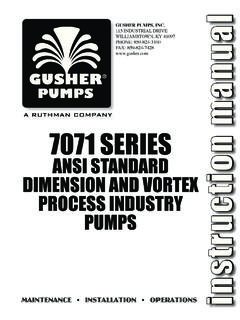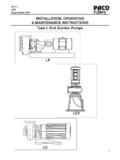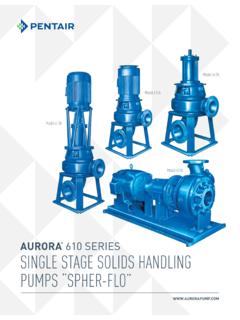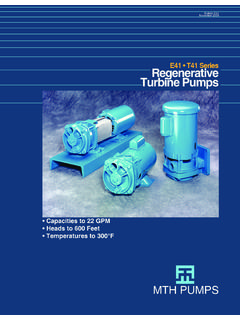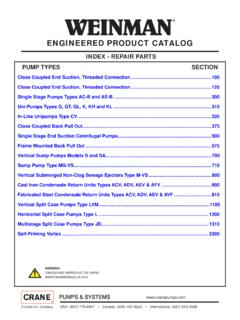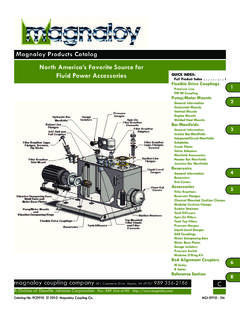Transcription of VERTICAL AND HORIZONTAL END SUCTION PUMPS …
1 VERTICAL AND HORIZONTAL END SUCTION PUMPS installation , OPERATIONAND MAINTENANCE MANUALi n s t r u c t i o n m a n u a li n s t r u c t i o n m a n u a lGUSHER PUMPS , INDUSTRIAL DRIVEWILLIAMSTOWN, KY 41097 PHONE: 859-824-3100 FAX: installation OPERATIONS INDEX VERTICAL end SUCTION pump installation ..3 VERTICAL end SUCTION pump operation ..3 VERTICAL end SUCTION pump general repair ..4 VERTICAL end SUCTION CM (coupled motor type) general repair ..5 HORIZONTAL end SUCTION pump installation ..6 HORIZONTAL end SUCTION pump general repair ..7 HORIZONTAL end SUCTION CM (coupled motor type) general ..9 Ball bearing replacement .. 0 Trouble Shooting .. Warranty .. General Information: Although Gusher PUMPS , Inc. have taken every precaution to prevent damage in ship-ment we recommend that you check the pump for visible damage such as cracks, holes, indentations, etc. upon arrival. Some damage isn t visible such as a bent shaft. This is checked by turning the rotating element of the pump by hand to assure free rotation (re-move the motor fan cover if necessary).
2 You should now check the name plate to be sure that you have received what you ordered. Here we provide a list of the things to check and record for future reference. Keep this manual in a convenient location for quick reference. Model .. Motor frame size ..; Impeller Dia..; Ph..; Cy..; RPM ..; Amps .. Voltage ..; Serial No.. Performance .. @ .. in 3 installation VERTICAL Pump: Gusher VERTICAL end SUCTION PUMPS with integral shaft is easily installed and put into service. With the one piece shaft design there is no couplings to align, no shims or no special adjustments to make. With the use of one of Gush-er s clamp on brackets that fit around the stem s column the pump can be quickly set into position and bolted down. When piping your machine we recommend the use of as large a pipe as is practical from the pump to the point of de-livery. It is advisable to install a pressure gauge in the dis-charge line as close to the pump as possible.
3 It is also rec-ommended to install a gate valve in the discharge line down stream from the pressure gauge. It is IMPORTANT to note that the machine piping should be self supporting and in no way supported by the pump impeller housing or discharge connection. After the pipe is installed we recommend the pump rotating element be turned by hand to check for bind- ing. This is done by inserting a screw driver in the slots in the fan cover and turning the pump by hand. If there is a drag or if there is a tight spot you should check the piping system to be sure it is supported properly, if not, secure properly and recheck. When you are positive the pump is rotating free, wire the motor being sure to con-form to all state and local electrical codes. Before putting the unit into operation, check the direction of rotation by jogging the motor starter on and off. The direction of ro-tation is clockwise when viewing from the top of the mo-tor.
4 If the pump is turning the wrong direction, reverse any two of the line wires at the motor in the conduit box or at the motor starter. Operation: Before starting the pump the reservoir should be filled to the minimum level so as to completely sub- merge the pump impeller housing in the liquid which assures priming of the pump. Upon initial start-up we recommend that you check and maintain the minimum liquid level in your reser-voir, it is also advisable to check your piping for leak at this time. We also recommend that you check and record (use space provided) the pump discharge pressure, line volt-age, amperage being drawn by the motor and the operating temperature of the ball bearings. installation CM and CDM Style: For jobs requiring coupled motors the above installation instructions apply with the addition of the coupling align-ment, see page 5 for details on coupling alignment. At shut-off (valve in At operating discharge line closed) condition Pressure.
5 Voltage ..Amperage ..Temperature .. Temperature should be checked with a pyrometer, do not check by touch, temperatures that are hot to the touch are often well within the maximum operating temperature of 5OF. If a problem develops check trouble shooting section on page . If you are unable to solve your problem using this section, contact Gusher PUMPS , Inc. for assistance. 4 General Repair: DISASSEMBLY..Shut off main power switch and discon-nect the motor wiring. Close the inlet and outlet valves, dis-connect the piping at the unions and remove from service. Remove the screws securing the impeller housing ( 4) to the stem (9), remove the impeller housing. Take off the re-taining screw ( 9) and slide the impeller ( 5) and throttle sleeve ( 3) off the shaft (3). Take off the stem (9) by remov-ing four screws securing it to motor end bell and slide it off the shaft. Check for wear, replace worn parts where neces-sary and reassemble by reversing the procedure.
6 BALL BEARING the above steps to stem removal. Remove screws in fan cover & remove cover, loosen set screw in fan and remove fan, remove four screws securing upper end bell to stator and remove end bell, remove screws in bearing retainer (4), lay a block of wood or some other soft material on the floor and tap the shaft (3) and ball bearing (6) out of the stator and lower end bell using the weight of the stator as you drop the shaft on the block of wood lightly. (Fig. ) Tap the old bearings off the shaft and install new ones by following the instructions on page 0. To reassemble, reverse pro- End SUCTION PumpsINTEGRAL SHAFT Load Spring Ball Bearing3 Shaft4 Ball Bearing Retainer5 Snap Ring6 Ball Bearing6A Press Collar7 Grease Seal8 Rubber Slinger9 Stem 4 Impeller Housing 5 Impeller 6 Square Key or Woodruff Key 7 Impeller Retaining Washer 8 Lock Washer 9 Impeller Retaining Screw 0 Wear Ring Grease Fitting 3 Throttle Sleeve 4 Adapter 5 Locknut & Washer 6 Ball Bearing Housing 7 Motor Base Bracket ( CM Models) 8 Ball Bearing Retainer ( CM Models)30 Discharge Alignment: You will need a straight edge and a feeler gage to check coupling alignment.
7 To check parallel alignment, place the straight edge on four sides of the coupling. If the edge lies flat on all four sides, parallel alignment is okay. To check angular alignment, the feeler gage is placed in four different locations between the coupling halves 900 apart, if the distance is the same in all four positions, the angular alignment is okay. The faces of the coupling should be spaced apart slight-ly, just enough that the two faces don t rub (approx. /8 ). VERTICAL End SUCTION CM & CDM STYLEG eneral off main power switch and discon-nect the motor wiring. Close inlet and outlet valves, dis-connect the piping at the union and remove from service. Remove screws securing the impeller housing ( 4) to the stem (9), remove the impeller housing. Take off the re-taining screw ( 9) and slide the impeller ( 5) and throttle sleeve ( 3) off the shaft (3). Take off the stem (9) by re-moving four screws securing stem to bearing housing ( 6).
8 Check for wear, replace worn parts and reassemble by re-versing procedure. BALL BEARING the disassem-bly procedure to stem removal. Remove four screws se-curing pump to motor base bracket ( 7), remove retaining rings from coupling spider and remove spider, and sepa-rate pump from motor. Remove lock nut & washer ( 5), drop pump shaft end on piece of wood placed on the floor. (Fig. # ) Ball bearing retainer ( 8) is installed using the thermo expansion method of installing ball bearings and you may have to put the unit in an arbor press to remove. (Figure # ) Ball bearing ( ) is mounted on the shaft prior to reassembly and ball bearing (6) is installed in bearing housing ( 6) prior to reassembly. For proper method of ball bearing installation see page 0. To assemble, insert shaft through bearing housing and reverse above procedure. 6 installation HORIZONTAL Pump: Before starting any centrifugal pump the SUCTION line and impeller housing must be filled with liquid being pumped.
9 If the pump is located below the liquid level in the reservoir the pump may be primed by removing the vent plug and al-lowing liquid to fill the SUCTION line and impeller housing. To prime a pump operating under SUCTION lift condition there must first be a foot valve installed in SUCTION line. Liquid is then poured into the impeller housing through the vent plug or through the check valve in the discharge line until SUCTION line and housing is filled with liquid being pumped. The unit will remain primed as long as the foot valve is operational. SUCTION SUCTION pipe must be kept free of air leaks. This is particularly important when the suc-tion line is long or the static lift is high. The SUCTION pipe should always slope gradually up toward the pump. Any high point in the pipe will become filled with air and pre-vent proper operation of the pump. A concentric reducer should not be used in a SUCTION line, it forms air pockets in the top of the reducer and the pipe.
10 Use an eccentric reducer instead (see illustrations). Small air pockets that may cause problems are often formed in the top of gate valves mounted vertically in SUCTION line. We recommend gate valves in SUCTION lines be laid so that the stem is in HORIZONTAL position. DISCHARGE recommend the use of a check valve and a gate valve in the discharge line. The check valve should be placed between the pump and gate valve to prevent liquid from running back through the pump and possibly causing damage to the drive motor. The gate valve is used when starting and priming and when the pump is to be shut down. This valve should be closed when stopping the pump when a foot valve is used, this prevents water hammer. This is important when the pump is used against a high static lift. We recommend increasing the discharge pipe to the next size larger than the pump discharge size. This is done by placing a concentric reducer between the check valve and the pump.



